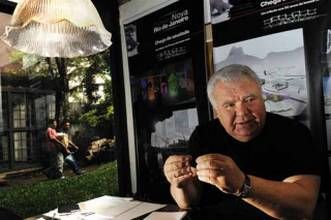
The soul of Green City - Jaime Lerner.

Bus Rapid Transit reduces public driving.
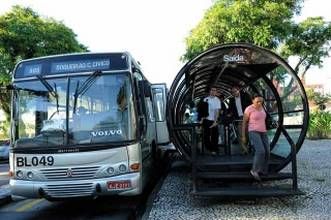
Bus lanes and multi-purpose shelters are set up to be beautiful and practical.
Establish a Sustainable Ecological City
Professor Lin Zhengyi said that what is known as "the most innovative city in the world" is Curitiba in Brazil. With a population of 175,000, it was selected by the United Nations as one of the few "most livable cities." Because the original transportation system was cluttered, each person owns only one-tenth of the Taipei population. After the improvement plan, including bus rapid transit, green exchange system to dispose of wastes, land acquisition to create green belts, reuse of old buses and buildings, land planning around the river bank, etc., it has become a modern green city.
In September 2005, Jamie, the former mayor of Curitiba, was invited to visit Taiwan. Jaime Lerner pointed out: "The city is not a problem, the city is the solution itself!” That’s Rayle's governance thinking. When Jamie Leller had just served as Mayor of Curitiba, the flooding problem was already very serious. If engineering flood control is used to solve the problem of surface surface, it will cost millions of dollars. Then the team "The Institute of Research and Urban Planning of Curitiba (IPPUC)" transformed the river bank into a riverside park as a buffer zone for floods. When traffic problems such as urban traffic jams are very urgent, most of the heads of the city are responding by constructing a huge rapid transit system. The IPPUC team
considers the cost and time of the MRT system's investment, and designs a transparent glass tubular station with a height equal to the bus to facilitate passengers getting on and off the bus. . At the same time, the planning for entering the station, ticketing, moving lanes, and barrier-free passages should be as considerate as possible. A bus that is three times longer than a normal car body enters a station every minute, and its capacity and efficiency are no lower than those of the MRT. This design can also save about 42% of fuel consumption.

The soul of Green City - Jaime Lerner.

Bus Rapid Transit reduces public driving.

Bus lanes and multi-purpose shelters are set up to be beautiful and practical.
When the new bus was produced, the old bus body was used as an action library, a childcare center, or a bus restaurant. On the one hand, as a symbol of nostalgic
education, on the other hand, when resources are continuously recycled, the problem
of rubbish can be reduced a lot. The city of Curitiba funds “rubbish procurement
projects” and uses green exchange mechanisms to solve waste disposal problems. As
alleys in the residential areas of the poor have not been paved with asphalt, trucks that
receive garbage are unable to enter, and even regular garbage removal and
transportation work cannot be done. As a result, the city of Curitiba parked small
trucks on more than one hundred fixed points in the city. When the collection time is
up, the residents take out a bag of garbage to exchange food. For example, sixty
kilograms of garbage can be exchanged for sixty exchange cards, which is sufficient
for exchanging a month's food for the whole family (also can be exchanged for bus
tickets, school exercise books, or Christmas toys). Two kilograms of recyclable
materials can be exchanged for one kilogram of food. The vast majority of food is the
government's purchase of overproducted agricultural products from farmers. On the
one hand, it solves the problem of waste; on the other hand, it also improves the
quality of life of low-income households while also making good use of surplus agricultural products. Although former mayor Jamie Lerner humbly said that the city
of Curitiba in Brazil is a developing country, land use, transportation planning and
community participation in Curitiba are all we can learn.
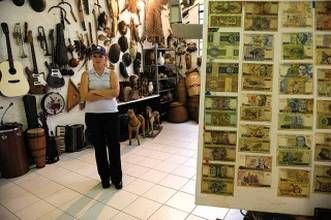
The recycling factory is attached to the museum to display various treasures
and antiques from the past to educate visitors to cherish resource.
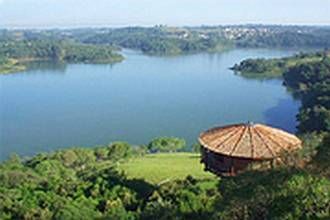
Buy land to create green.
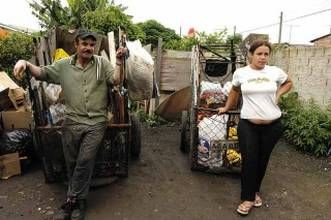
The municipal government implements
the "Green Exchange Program" to exchange one kilogram of food for every four kilograms of waste recovered.
Reference:
Corporate Environmental Law Association of Taiwan
http://e-info.org.tw/column/biodiv/2005/bi05101701.htm
http://e-info.org.tw/node/29017
Images from:
RHYTHMS MONTHLY
http://www.rhythmsmonthly.com/?p=5830
Corporate Environmental Law Association of Taiwan
http://e-info.org.tw/2005/10/1017/051017A.htm
- Top -
© Copyright 2018 Taipei Municipal Daan Elementary School - All Rights Reserved